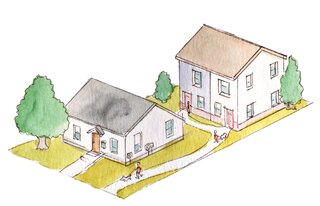In Portland, Oregon, the Paths to Homeownership Are Multiplying
The city’s low-density zoning reform in August of last year opened the door to lot splits and smallplexes—and developers, homeowners, and lenders have gotten busy building.

The city’s low-density zoning reform in August of last year opened the door to lot splits and smallplexes—and developers, homeowners, and lenders have gotten busy building.
In 2015, Eric Thompson heard that his city of Portland, Oregon, was considering overhauling its low-density zoning. He joined the project’s advisory committee with one paramount goal: to stop it.
Thompson had built a local business knocking down small old homes in fancy parts of town and replacing them with bigger new ones—3,000 square feet or so. Now, the city was looking to rechannel housing investment away from projects like those and toward smaller homes. It seemed like a dagger aimed at his livelihood.
"All I’d ever built for previously were the 5 percenters who could afford what today would be a million-dollar-plus house," Thompson recalls.

Portland loosened rules for backyard accessory homes, allowing up to two at 800 square feet each. They no longer have to be smaller than the existing home.
Illustration by Alfred Twu for Sightline
Seven years later, today’s Eric Thompson could tell his former self a thing or two. At his firm, Oregon Homeworks, permit applications are flying out the door. His team has 70 homes around the city in its pipeline, enough to keep themselves busy for the next year. They’re all in the same leafy, close-in neighborhoods Thompson has long built in—except his sale prices have fallen sharply, to $425,000 to $550,000. They’ll be the least expensive newly built homes on the block by far.
It’s not exactly the bottom of the market. But these days, he’s mostly left the "5 percent" behind and is signing deeds over to schoolteachers and restaurant managers, people who never thought they’d be able to afford new construction.
Thompson’s business is alive and thriving; every one of its recent projects has turned a profit, he says, and financing hasn’t been too hard. Thompson’s secret: the argument he lost seven years ago. Despite his efforts in 2015, new homes of the size he once built are now illegal in most of the city. But in exchange, almost any residential lot is now allowed to have up to four modest homes on it.
Welcome to Portland, America’s new test tube for rediscovering the "missing middle" of the housing market.
The Fall and Rise of the Triplex
Portland’s zoning reform, which took effect in August 2021, is part of a wave of similar changes across the United States and Canada. Houston, today the nation’s least expensive boomtown, arguably led the way by slashing minimum lot sizes to 1,400 square feet with a two-step reform in 1998 and 2013. Minneapolis made a splash when it legalized triplexes citywide in 2018. Cities from Walla Walla, Washington, to Greeley, Colorado, to Charlotte, North Carolina, have all made similar changes or set the wheels in motion to end bans on duplexes and lot splits.
Don’t call it a revolution, though. Call it a comeback.
One hundred years ago, duplexes, triplexes, quads, townhouses and backyard homes—"middle housing," they’ve recently been called—were legal almost everywhere. And they were fairly popular. In those days before the 30-year fixed-rate mortgage, one path to homeownership was to build a small duplex, rent out one side, and live in the other. Thanks to countless ad hoc arrangements like that, millions were built, often scattered through the low-density neighborhoods of the day. One out of 13 homes in the United States is part of a two- to four-unit building. But then, driven by a movement that was often deliberately segregationist, such buildings were gradually banned from most of our urban land between 1920 and 1960. Today these relatively affordable attached homes are disproportionately old, by far the oldest on average of any structure type.
In other words, this heartwood of the country’s middle-class housing stock is slowly rotting out.

Portland now allows "smallplexes," defined as two- to four-unit structures, to share a lot. The lot can be subdivided among a few side-by-side homes, even if some resulting lots don’t abut the street, providing low-cost ownership options.
Illustration by Alfred Twu for Sightline Institute
In the last few years, as the issue has gained attention on both the left and right, politicians have turned to a new strategy for planting a new generation of mid-priced homes: state legislation. Statewide middle-housing bills have been introduced in 14 states since 2019, from Montana to North Carolina, and passed in three: Oregon, Maine, and (in 2021) the nation’s biggest housing market, California.
California’s zoning reforms are likely to bring change to the construction lending market, says Susan Brown: first a trickle, then a torrent. Brown, an Oregon-based mortgage banker, spent 17 years scaling up a regional construction lending program for Umpqua Bank and now consults with small to midsize companies to launch their own. One of the niches she carved out for Umpqua was financing to help homeowners add accessory cottages and, now, other middle-housing infill projects.
A big constraint in Brown’s lending was the difficulty of reselling the resulting loans to Fannie Mae and Freddie Mac, the federally chartered loan companies.
"That was our argument for years: If we could get Fannie and Freddie’s attention by having California do something, then we’d get somewhere," says Brown.

A small detached home in inner Northeast Portland might have wound up demolished under the city’s old low-density zoning rules that allowed only oneplexes. Now, small detached homes can be added to the lot, and also several attached homes.
Photo by Michael Andersen for Sightline Institute
See the full story on Dwell.com: In Portland, Oregon, the Paths to Homeownership Are Multiplying
Related stories:
